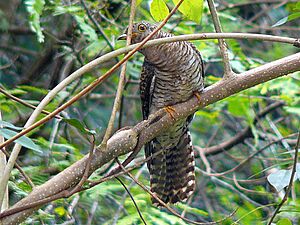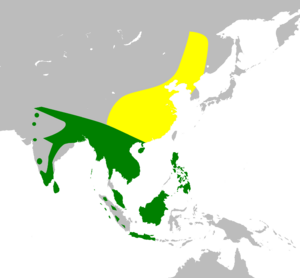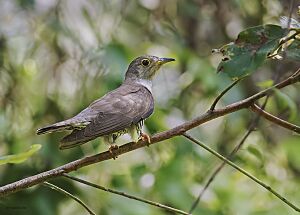Indian cuckoo facts for kids
Quick facts for kids Indian cuckoo |
|
|---|---|
 |
|
| Conservation status | |
| Scientific classification | |
| Genus: |
Cuculus
|
| Species: |
micropterus
|
 |
|
The Indian cuckoo or short-winged cuckoo (Cuculus micropterus) is a type of cuckoo bird. It lives in the Indian subcontinent and Southeast Asia. You can find it from India, Bangladesh, Bhutan, Nepal, and Sri Lanka all the way east to Indonesia. It also lives north in China and the Russian Far East. This bird likes to be alone and is a bit shy. It lives in forests and open woodlands, sometimes as high as 3,600 meters.
Contents
What Does it Look Like?
This cuckoo is a medium-sized bird. Both male and female Indian cuckoos look similar. Their upper parts are grey, and their undersides have wide black stripes. Their tail has stripes too, with a dark band near the end and a white tip.
Younger birds have white marks on their head. Their chin and throat are white, which stands out against their dark face. Very young cuckoos are browner. They have wide white tips on their head and wing feathers. The skin around their eyes is grey to yellow. Their eyes are light brown to reddish.
Female cuckoos are a bit lighter grey on their throat than males. They also have more brown on their chest and tail. The stripes on their belly are thinner than on males. Baby cuckoos have an orange-red mouth and yellow edges around their mouth.
What Does it Sound Like?
The Indian cuckoo has a loud call with four notes. People describe its call in different ways. Some say it sounds like "orange-pekoe" or "bo-ko-ta-ko". Others hear "crossword puzzle" or "one more bottle". In northern India, you might hear one calling bird for every 2 square kilometers during the breeding season.
What Does it Eat?
Indian cuckoos mainly eat fuzzy caterpillars and other insects. Sometimes, they also eat fruits. They usually find their food in the tops of trees. They pick off insects from leaves and branches. Sometimes, they fly out quickly to catch flying termites. Very rarely, they might hover low near the ground to find food.
Where Does it Live?
This bird is found across a large part of Asia. It lives from the Indian subcontinent all the way east to Southeast Asia. Indian cuckoos prefer forests where trees lose their leaves (deciduous) or stay green all year (evergreen). They can also be found in gardens and thick bushes.
Some Indian cuckoos fly south for the winter. However, some groups of them live and breed in southern areas all year. The cuckoos in the Amur region of Russia also fly to different places for winter.
How Does it Reproduce?
The Indian cuckoo is a brood parasite. This means it lays its eggs in the nests of other birds. In Russia, female cuckoos sometimes pair up with specific males during the breeding season. The male might distract the parent birds of another species from their nest. This gives the female cuckoo time to lay her egg.
Indian cuckoos usually lay a single egg. They often choose the nests of drongos and crows. Brown shrikes have also been recorded as host birds in Russia. Before laying her own egg, the female cuckoo removes and eats an egg from the host nest.
The breeding season changes depending on the area. It is from May to July in northern China. In India, it's from March to August. In Burma, it's from January to June, and in the Malay Peninsula, from January to August.
Some birds that have raised Indian cuckoo chicks include black drongos and ashy drongos in India. Other hosts are the black-headed oriole and the streaked spiderhunter.
Cuckoo eggs hatch in about 12 days. Brown shrike eggs, for example, take 15 days to hatch. When a young cuckoo hatches, it has a special instinct. If something touches its back, it will push out other eggs or baby birds from the nest. This instinct helps the cuckoo chick get all the food from its host parents. It stops doing this soon after.
Its Place in Culture
The loud calls of the Indian cuckoo have many different meanings in stories and songs. In Bengali, people say its call sounds like "bou-kotha-kao," which means "Bride, please speak." In Uttarakhand and Nepal, it sounds like "kafal pako," meaning "the kafal fruit is ripe." This is because the cuckoo calls more in May and June when the fruit ripens.
In Malayalam, it is known as "Vishupakshi." Its call is interpreted as "Kallan chakkayittu," which means "thief stole jackfruit." The meaning of the call does not change much between different regions. In the Kangra Valley of India, people believe the call is the soul of a dead shepherd asking "where is my sheep."
In China, the call has many different meanings. Some hear "why not go home" or "single lonely." Others hear "mother-in-law beats me" or "catfish congee." The Soliga people interpret the call as "ke:ta satto, makka ketto," meaning "Ketha (a person's name) died, his sons cried." In Vietnamese, the call is interpreted as "bắt cô trói cột," which means "take a woman and tie her to a post." This comes from a legend possibly from the Mảng ethnic group.



